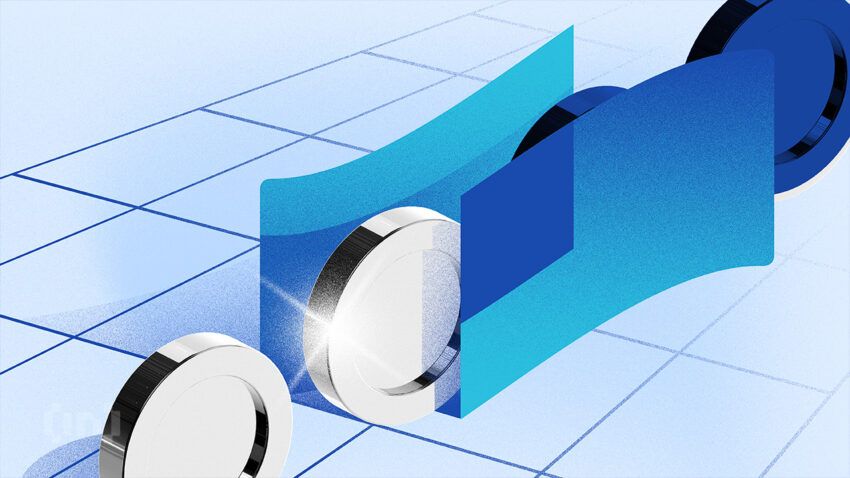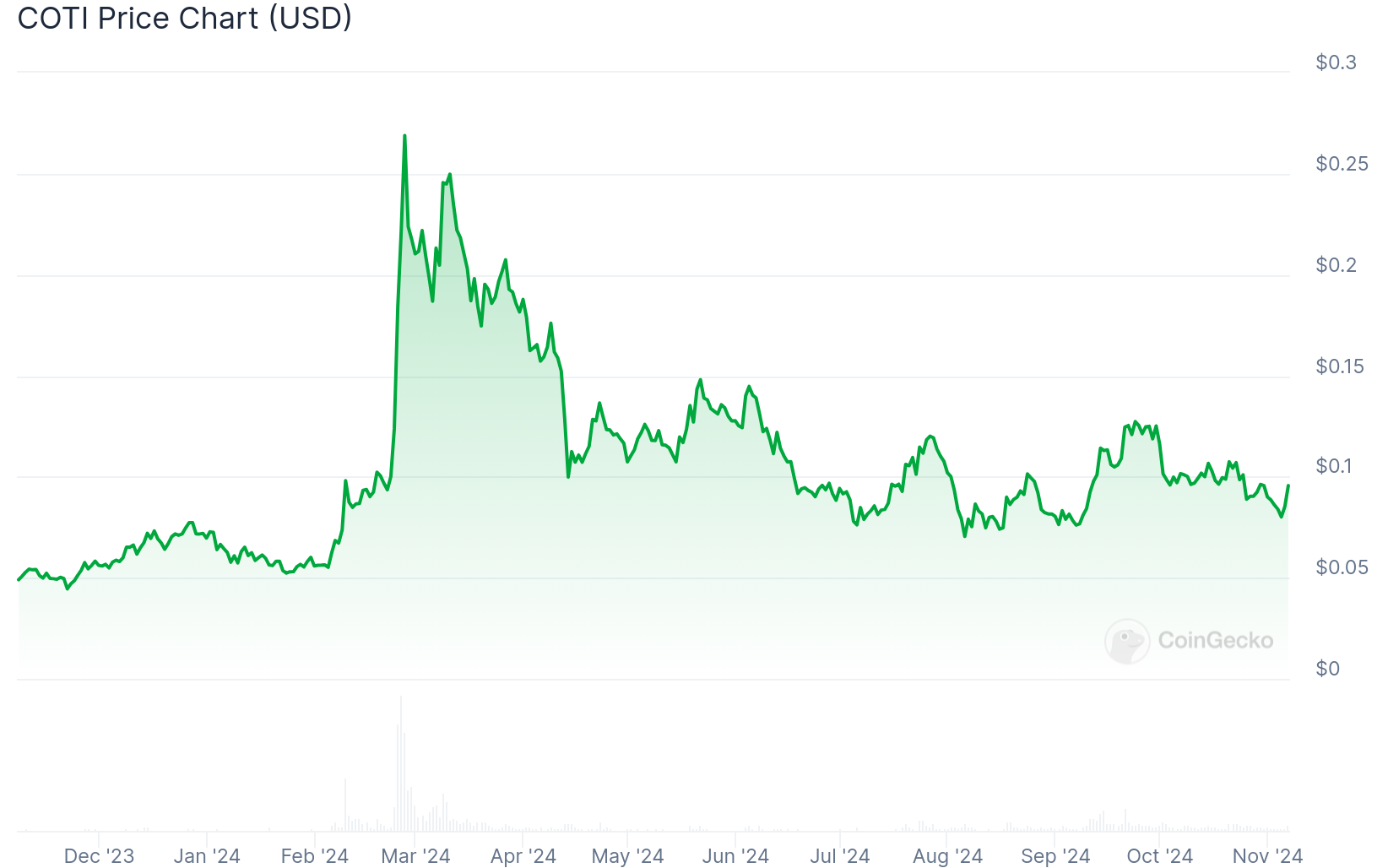The payment industry is rapidly adopting applications of blockchain to solve cross-payment problems. Among several companies harnessing this technology is COTI. Tagged as “Currency of the Internet,” it explores the potential of blockchain technology and allows companies to build their own payment solution. In this guide, you’ll learn everything about this payment solution and everything else you need to know.
KEY TAKEAWAYS
► COTI is a Layer 1 blockchain platform that enables businesses, organizations, and governments to issue their own digital currencies to enhance payment options for customers.
► COTI utilizes a unique consensus algorithm called Proof of Trust (PoT), which combines elements of Proof of Work (PoW) and Directed Acyclic Graph (DAG) structures.
► The platform offers a suite of financial tools, including COTI Pay, debit cards, wallets, and a Treasury system that allows users to deposit funds and earn rewards.
► COTI has formed significant partnerships, notably with Cardano, integrating ADA Pay into its system and receiving substantial investment to further its development.
What is COTI?
COTI is a layer 1 blockchain platform that offers decentralized payment solutions, enabling businesses, organizations, and governments to issue their own coins. For instance, users can build branded stablecoins to improve payment options for customers.
It is an enterprise-grade platform that embodies the next generation of digital currencies and a payment system that is simple, transparent, reliable, fast, and scalable.
Just as seen with platforms in different sectors like Airbnb in the lodging industry and Uber in the transportation industry, COTI came up with a payment network that seeks to solve problems in the fintech space. It aims to improve the online payment experience for both buyers and sellers.
Ultimately, the project brings common standards of the traditional financial industries into the blockchain space. These standards include financing, remittance, loyalty programs, and cross-platform payments, as well as basic DeFi use cases.
The network also has its own unique staking variant called Proof of Trust (PoT), a combination of PoW and DAG — to achieve consensus.
The platform has also introduced bank accounts and VISA debit cards to offer a direct and transparent connection between the fiat space and the crypto world.
Among several partnership deals COTI closed is Cardano. The team has invested about half a million dollars into COTI, and it accepts ADA Pay with integration into many fiat currencies.
The history of COTI
COTI was founded in Jun. 2017, and it’s headquartered at Line Wall Road in Gibraltar. COTI has a team of experienced experts who hail from various professional backgrounds but are united by a shared interest in blockchain, decentralization, and privacy. The team includes engineers, developers, bankers, and researchers from other relevant industries.
COTI has committed to solving the problems associated with traditional trading services, including regulations, security issues, high energy consumption, and a lack of broad trust in blockchain technology. It does this with its DAG-based protocol and a scalable framework that is fast and exclusive.
How does COTI work?
As stated earlier, COTI was founded to build a decentralized payment network that allows businesses to attain maximum efficiency. It consists of a few components, including Trustchaim, a multi-DAG data structure, Node clusters, and Proof of Trust to reach consensus.
Trustchain is the underlying technology for the COTI ecosystem and products. It revolves around a unique agreement algorithm based on machine literacy. This algorithm significantly reduces transaction costs and boosts transaction speed by tagging trust scores to data and grouping them in chains.
The network’s whitepaper indicated that Trustchain is based on a multi-directed acyclic graph (DAG) data structure, more like a graph than a blockchain. Multi-DAG has been known to facilitate scalability. Unlike blockchain technology, multi-DAG is a data modeling or structuring tool that records transactions on top of one another; that is, multiple nodes can process transactions simultaneously.
Overall, the COTI platform combines infrastructure, services, and network layers to build a comprehensive payments solution that is customizable.
Proof of Trust (PoT) consensus
COTI uses Proof of Trust as a consensus algorithm. Unlike Bitcoin’s Proof of Work (PoW) algorithm, Proof of Trust is energy efficient. Instead of mining, like in PoW, Proof of Trust works by allocating each network user a Trust Score and using a DAG to process transactions.
The aim of using Trust Score is to enhance good network behavior, reduce transaction fees, and improve good network service. For instance, with Bitcoin, an increase in scalability automatically means increased energy consumption.
COTI’s multi-DAG solves this issue. It creates a cluster and tags each transaction in that cluster to the user’s trust score. So to be a participant in the network, you need to be connected to prior transactions with the same Trust Score threshold.
PoW linearly approves transactions, while multiple transactions can occur simultaneously with PoT. This solves the scalability issue.
MultiDAG layer
To better understand this, let’s compare it to Ethereum. First, it’s vital to note that both used distributed ledger technology that records transactions and the balances of users’ addresses.
COTI utilizes its MultiDAG to enable token issuers to brand their product and set their own rules according to their needs and use cases. COTI MultiDAG gives token issuers overall control over their network; they set up their own rules. This gives room for unlimited instances and tokens without any network degradation.
MultiDAG instances retain all the inherent features of the COTI ecosystem, including low fees, speed, consistency, privacy, scalability, and regulatory compliances. So, when a transaction occurs on this MultiDAG, fees are in COTI, increasing the demand for the COTI coin and improving the value of the network.
MultiDAG 2.0
Following the release of Trustchain 2.0, the platform is already working on an improved version of MultiDAG tagged MultiDAG 2.0. The main feature of this is that users will be able to issue their tokens on the trust chain and, at the same time, transact using the tokens across multiple wallets, such as COTI pay and other supported networks.
COTI V2
COTI V2 is a privacy-centric layer 2 built on Ethereum that was launched in 2024. It uses Garbled Circuits, a cryptographic protocol, to enable high-speed, lightweight, and confidential transactions. This approach creates scalable private computations on the blockchain, addressing the need for data privacy in decentralized applications.
COTI for business
One of the main objectives of COTI is to offer optimized financial solutions to businesses. Through its COTI Pay, companies and organizations can process all types of payments. It can also handle payments with stablecoins, credit cards, cryptocurrencies, and native coins.
What makes COTI unique?

COTI seems to be different in multiple ways. Privacy is a distinct feature of COTI. The platform prioritizes data protection, as transactions cannot be tracked to a specific user. It does this by creating several addresses with a one-way hash for each transaction.
Another feature of the protocol is security, as users must comply with Know Your Customer (KYC) regulations and follow Anti-Money Laundering rules to join the ecosystem.
Use cases of COTI
Another thing that makes this protocol unique is its use cases. though it is a payments network, it has a few features that separate it from legacy services.
Processing tools
The COTI platform designs tools that allow businesses to process payments from COTI Pay wallet users. These tools enable merchants to send invites to consumers who visit COTI Pay-integrated merchants but do not hold legacy wallets.
Also, merchants will be able to decide if they want to integrate their websites and payment method with COTI Pay through an API or iFrame. The integration process is supported by major e-commerce platforms such as Shopify, eBay, and Magento.
Debit cards
For an easy integration process, COTI Pay gives users access to debit cards that connect directly to COTI Pay wallets. The idea behind this is to ease the payment process when dealing with users not using COTI Pay yet.
These users will be able to choose their preferred currency upon creating a virtual debit card. Also, the COTI-X feature helps users in dealing with different currencies.
When a transaction is made using a card connected to a currency that does not match the payment currency, COTI-X values the currency and converts it to the equivalent amount of the card-linked currency. This improves transparency and removes the need for middlemen exchange fees.
Wallets
Another use case of COTI is offering a multi-currency wallet that gives fast and seamless access to COTI Pay. These wallets are compatible with many consumer payment methods.
Peer-to-peer transactions
COTI Pay users will be able to make quick and safe transfers to their peers who hold COTI Pay wallets. Notably, these transfers come with negligible fees (depending on the users’ Trust Scores and the chosen currency).
Nearby wallet-to-wallet transactions
COTI Pay wallet holders will also be able to transfer funds securely and instantly to other COTI Pay wallet holders via near-field communication.
Safe storage of digital and fiat currencies
Like bank accounts, COTI Pay users can use their COTI Pay wallets to save funds in digital and fiat currencies. In addition, they will be able to deposit funds into their wallets using cards, bank wire, and popular cryptocurrencies like Bitcoin and Ethereum.
The treasury: Deposit and earn
COTI Treasury incorporates rewards from COTI’s ecosystem products and services into one platform. Similar to other lending platforms, users can deposit COTI in a pool and get incentives for their stake via the Treasury.
You can stake by depositing your COTI into the Treasury pool and adding more tokens to your active deposits any time you wish. Deposits will earn an APY in Treasury rewards (COTI) based on the deposit multiplier and the lock period. Furthermore, deposits give users a right to the ecosystem and a share of the overall treasury pool.
After you have deposited your COTI, you can add more of them and withdraw the deposits and rewards. Once the set locked period has elapsed, you can set a new lock period, which is usually 30 days, three months, six months, or a year.
What is the COTI token?

COTI is the native currency of the COTI ecosystem. The token operates on three different mainnets: Trustchain, Ethereum, and BNB Chain.
- Trustchain: COTI’s native mainnet
- Ethereum: COTI uses the ERC-20 token on the Ethereum network. As a result, it’s traded on major exchanges and wallets.
- BNB Chain: COTI also uses the BEP-2 and BEP-20 token standards.
Tokenomics

COTI has a circulating supply of about 1.8 billion tokens and a maximum supply of 2 billion. The token allocation and distribution goes as follows:
Token allocation
- Token sale: This covers both private and public sales, with a locked-up period of up to 24 months. It accounted for 30% of the total token supply.
- Reserve: The platform kept 22% of the total token supply in reserve. It will be used to boost the growth and stability of the network.
- Team: The team was given tokens as incentives for early involvement and continuous effort in stabilizing the network. The token is locked up for the first six months and then released every quarter over 24 months. Also, they get 15% of the total token supply.
- Partners and Advisors: They get 10% of the total supply in recognition of the resources they provide to develop COTI projects
- Validators and users: 13% of the token supply goes to the network validators to recognize their early participation.
- Liquidity: 10% of the total token supply is also given to provide liquidity to the thriving COTI market.
Primarily, COTI is used to transact within the ecosystem. This includes fees and staking. The network also offers a wide range of potential payments and other applications to boost token utility and stability.
COTI holders can deposit funds to the treasury pool for DeFi staking and earning rewards. In addition to payment, COTI holders can also use a bridge to transact between two different blockchains.
Token governance
To run a Full Node, users must stake 100,000 COTI for each node and set the fee they are willing to charge per transaction. Likewise, they can stake 250,000 COTI to run an Advanced Node and get a 25% APY. The rewards are based on fee distribution mechanisms and staking requirements.
Roadmap
COTI ecosystem was founded in Jun. 2017 and released its whitepaper three months later in Sep. 2017. The following briefly details the roadmap.
- Token 1 Sale – Jun. 2018
- Test net release – Dec. 2018
- Mainnet – Jun. 2019
- IEO – Jun. 2019
- Staking – Mar. 2021
- Main net upgrade – Jun. 2021
- Launch of Treasury- Sep. 2021
- COTI Mainnet 2.0 – Nov. 2021
- COTI V2 launch – May 2024
How to buy COTI

COTI is listed on many popular exchanges, including Binance, BinanceUS, and Coinbase. Follow these steps to buy COTI on Binance.
- Register or log in to your Binance account if you already have an account.
- Click on the “Markets” tab: This is on the homepage on the navigation bar. Upon clicking, it will bring out many available coin pairs and search for COTI. It will also display relevant coins COTI is paired with. Choose one based on your preference.
- Click COTI/USDT: Upon doing this, you will see the price chart, then you can use different order types, such as a Limit, Stop Limit, and Market order.
- Click Buy.
- Insert the amount you wish to buy, and you will be credited.
What is the future of COTI?
COTI’s targeted market is the fintech industry. This is a huge market need, as many projects have not been able to solve the cross-border issues and other problems in the payment industry.
The project might have a good market share and be a good payment service provider. However, the platform is still very young, and for it to achieve complete scalability, merchants, market makers, and mediators need to adopt it.
Frequently asked questions
Is COTI a good crypto?
What is COTI in crypto?
Can I buy COTI crypto?
What is COTI used for?
Disclaimer
In line with the Trust Project guidelines, the educational content on this website is offered in good faith and for general information purposes only. BeInCrypto prioritizes providing high-quality information, taking the time to research and create informative content for readers. While partners may reward the company with commissions for placements in articles, these commissions do not influence the unbiased, honest, and helpful content creation process. Any action taken by the reader based on this information is strictly at their own risk. Please note that our Terms and Conditions, Privacy Policy, and Disclaimers have been updated.




